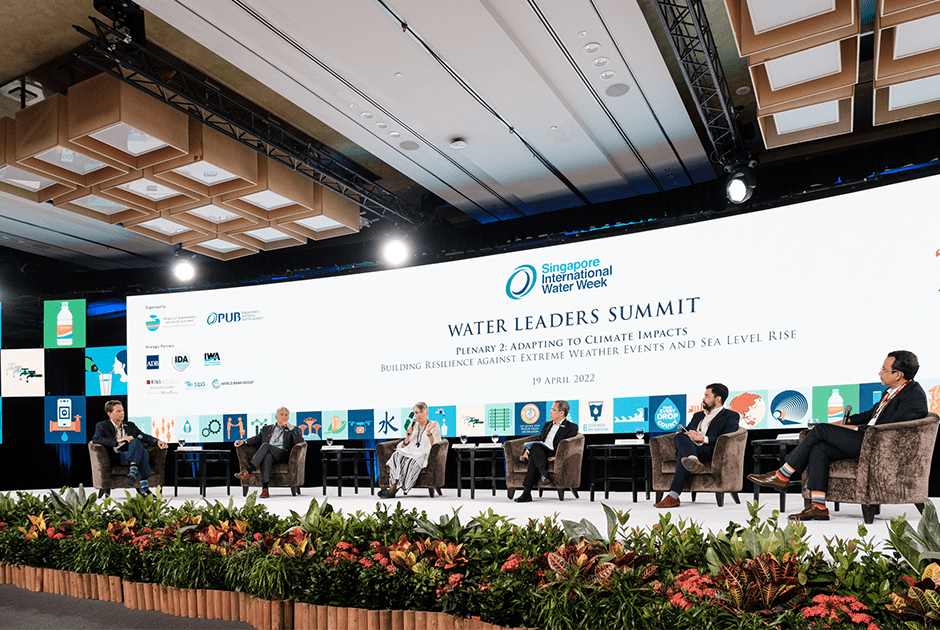I recently took to the stage at the Singapore International Water Week together with international delegates from the private and public sector to discuss climate change and coastal resilience in our cities and communities. The conversation has progressed beyond looking at resilience of assets, to private sector and governments alike looking for transformative action at the boardroom level. While topics varied from economic modeling solutions and holistic policies to their impact on creating equitable, sustainable societies; one thing that stood out was a common sense of purpose towards finding integrated solutions that protect, benefit and improve quality of life for all.
The science is clear – we must act now.
With the Intergovernmental Panel on Climate Change’s (IPCC) third installment in its Sixth Assessment Report, and increasing measures being taken by clients and governments to look at climate action as a priority, we’re no longer debating whether climate resilience pays off. It’s clear that it does. The recent severe impacts of weather events resulted in enormous damage in places without adequate protection, while places that have made timely investments in their resilience were saved.

Scientists recognize that the climate crisis has increased the probability of extreme events, making conditions worse and often disproportionately affecting marginalized communities. So, there’s a clear case for action and investment. But one of the problems that cities and developers face while planning for climate resilient urban developments, is the fact that the business case for resilience is often unclear: what exactly are the costs and benefits and how are these benefits distributed amongst the different stakeholders?
There’s greater value in looking beyond adaptation, towards mitigation

Over one-third of our world’s population lives within 100 kilometers of coastal land1. Urban waterfronts play a vital role in climate resilience, and provide a unique opportunity to capture urban living at its fullest for local communities, as epicenters of economic and social activity.
But, with rising sea levels fueled by climate change, flooding has become more frequent along coastlines. In several US coastal cities2, for example, it has increased five to ten-fold since the 1960s alone. If we remain inactive, this can have catastrophic effects on citizens, infrastructure and the economy. While in the past, we’ve seen cities and federal administrations taking action the day after the disaster, we’re increasingly seeing clients today looking towards mitigation as the answer. A notable example is our work alongside New York City, since Hurricane Sandy, towards rebuilding resilience and preserving Lower Manhattan’s distinct and vibrant character through the implementation of the East Side Coastal Resilience Project and the Financial District and Seaport Climate Resilience Master Plan.
Like New York City, many cities and public sector organizations around the world are paying attention to climate data, like from the IPCC, and considering this in their decision making and action plans. Increasingly, they’re focusing not just on protection, but also mitigation, making investments through new funding mechanisms to drive private sector participation, better community awareness and proactive and collaborative strategies and measures to address resilience.
They recognize that climate mitigation and adaptation must go hand-in-hand to ensure sustainable solutions for sustainable ecosystems and safer communities.

The last couple of years, extreme heatwaves in Europe alternated with intense and widespread summer rainfalls, have resulted in devastating river floods, hundreds of casualties and billions of euros of damage in Germany and Belgium. However, the Dutch investment of over a billion euros in the ‘Room for the River’ fluvial widening and strengthening of the Meuse River Program, which Arcadis is proud to contribute to, paid off when damages in the Netherlands were limited and casualties amounted to zero. But plenty of challenges remain, with substantial damage along the tributaries of the Meuse, and a new extreme dry summer with water shortages already expected.
Integrated, nature-based solutions are more effective

You can only be as resilient as your neighbor. Droughts, rainfall and river flows do not stop at the border, so we need better cross-border collaboration and integrated solutions to effectively address it. For example, to solve flooding of downstream areas, we need to create more sustainable land use and water storage upstream in the catchments of our international rivers. This needs to be supported by policies, legislation and funding as an incentive for cross-border collaboration.
And with a sustainable lens, this also requires carbon neutral, nature-based solutions, bridging the gap towards a climate action-oriented approach. Biodiversity loss is being seen across the world. North America and Latin America have for example seen 33% and 94% biodiversity loss respectively since 19703. Nature-based climate solutions can contribute to halting this. While investment may initially seem expensive, private and public sector partnerships can prove cost effective in the long run, especially when it comes to operations and maintenance. Nature-based solutions have far wider benefits than most people realize, as some are harder to monetize than, for instance, the avoidance of future damage, or increased real estate and land value. But if you also count social benefits like increased health and safety and improved livability and attractiveness of cities; ecosystem benefits like reduced carbon footprint, increased biodiversity supporting reduced urban heat island effect; and finally reduced operation and maintenance costs and an extended asset lifespan, the ‘return on investment’, or ‘resilience dividend’ becomes obvious.
Making these connections may not always be easy, but there are forums and governing bodies that can act as catalysts. Arcadis is a member of the World Business Council for Sustainable Development (WBCSD), through which we collaborate with members to find solutions to operationalize net-zero, with nature positive and equitable strategies and solutions. One such WBCSD program we’re involved in is the ‘nature-based solutions’ workstream that looks at the business case for nature-based solutions, finding synergies between nature and climate, and maximizing the resulting benefits.
Resilience is for all
Finally, to truly address climate resilience as we think about solutions for the future, we must also understand the mechanism of inclusivity as outlined through the Sustainable Development Goals (SDGs). As corporations, it’s our responsibility and moral obligation to consider the needs of the communities and the world around us through our work. Nobody should be left behind.

Being responsive to societal expectations through public-private partnerships like the Shelter Program plays a huge part in accelerating climate action in developing countries.
And equally, with over 2,000 Arcadians involved worldwide, programs like this generate a sense of pride and inspire direct involvement in collectively making a difference through the work we do, improving quality of life.
Sources
1. NASA Science
2. US National Oceanic and Atmospheric Administration






